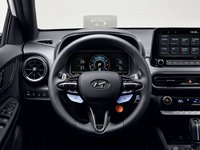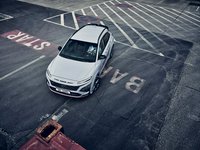Hyundai Kona (OS) facelift
Subcompact CrossoverProduct Gallery





Product Overview
Hyundai Kona (chassis code OS) facelift is a subcompact crossover in production from 2020. It is powered by either ICE engines of I3 and I4 variants or electric motors from 120hp to 280hp aided by batteries up to 64kWh.
Essentially a taller hatchback, the Kona is rather ugly and uninspiring. Those who drive offroad, for work or leisure, need to think twice before pulling the trigger: the Hyundai Kona is hardly the "offroader" that Hyundai would like you to think.
The KONA N is the first crossover to join the Hyundai N family. Brining the marque's high-performance tech to the "hot SUV" concept, the KONA N comes with a range of tricks under its sleeves for an otherwise practical, family vehicle.
The KONA N uses a turbocharged, direct-injected 2.0L T-GDI inline-4 engine that puts out 280PS and 392Nm of torque. Via a wet-clutch 8-speed DCT, power is sent to the front wheels with the help of Hyundai's N Corner Carving Differential, which is an electronically-controlled LSD that enhances corner handling under acceleration.
With launch control, which includes DCT-related optimizations, the KONA N can accelerate to 100km/h in 5.5 seconds.
Unsurprisingly, the KONA N comes with a suite of driver assist features.
Ratings
What we found
Neofiliac score 29%
Pros
- Up to 484km electric range
- Interesting Kona N
Cons
- Ugly
- Crossover nonsense
- Only available with small engines
- Poor suspension setup
What external reviewers found
External score 59%
Pros
- Good value for money
- Decent infotainment system
- Good standard equipment
- Comfortable ride
- Comfortable to drive
Cons
- Poor transmission
- Lack of practicality
- Not as fun to drive as the i30 N DCT
- Not quite as practical as the 1.0-litre
- Not class-leading
Your rating:
12345678910
?/10
Price Comparison
As associates of the merchants above, we earn a commission when you make a purchase using the supplied links.
Specifications
Variants shown:
1.0 T-GDi 120
1.6 CRDi 136
1.6 CRDi 136 AWD DCT
1.6 CRDi 136 DCT
1.6 Turbo-GDI 195 AWD DCT
1.6 Turbo-GDI 195 DCT
2.0 MPI 147 AWD CVT
2.0 MPI 147 CVT
Electric
Electric Lite
Kona N
[[{"Ft":"Capacity","Fn":"Cargo Capacity","Fv":"374 L / 13.2 cu-ft ~ 1156 L / 40.8 cu-ft"},{"Ft":"Capacity","Fn":"Engine Oil Capacity","Fv":"4.5 L / 4.8 qt"},{"Ft":"Capacity","Fn":"Fuel Capacity","Fv":"50.0 L / 13.2 gal"},{"Ft":"Capacity","Fn":"Passengers","Fv":"5"},{"Ft":"Capacity","Fn":"Payload","Fv":"530 kg / 1168 lbs"},{"Ft":"Chassis","Fn":"Brakes | Front","Fv":"Ventilated discs"},{"Ft":"Chassis","Fn":"Brakes | Rear","Fv":"Disc"},{"Ft":"Chassis","Fn":"Chassis Type","Fv":"Unibody"},{"Ft":"Chassis","Fn":"Power Steering","Fv":"Electric Steering"},{"Ft":"Chassis","Fn":"Suspension | Front","Fv":"MacPherson strut"},{"Ft":"Chassis","Fn":"Suspension | Rear","Fv":"Torsion"},{"Ft":"Chassis","Fn":"Suspension | Rear","Fv":"Multi-link"},{"Ft":"Chassis","Fn":"Tire Size","Fv":"205/60 R16, 215/55 R17, 235/45 R18"},{"Ft":"Chassis","Fn":"Tire Size","Fv":"235/40R19"},{"Ft":"Chassis","Fn":"Turning Circle","Fv":"10.6 m / 34.8 ft"},{"Ft":"Construction","Fn":"Battery | Capacity","Fv":"0.5 kWh (gross)"},{"Ft":"Construction","Fn":"Body Style","Fv":"5-door mild-hybrid SUV"},{"Ft":"Construction","Fn":"Body Style","Fv":"Subcompact crossover"},{"Ft":"Construction","Fn":"Colors","Fv":"Sonic Blue, Phantom Black Pearl, Atlas White, Cyber Grey Metallic, Dark Knight Grey Pearl, Ignite Red, Performance Blue"},{"Ft":"Dimensions","Fn":"Ground Clearance","Fv":"170 mm / 6.7 in"},{"Ft":"Dimensions","Fn":"Size | Height","Fv":"1565 mm / 61.6 in"},{"Ft":"Dimensions","Fn":"Size | Length","Fv":"4205 mm / 165.6 in"},{"Ft":"Dimensions","Fn":"Size | Width","Fv":"1800 mm / 70.9 in"},{"Ft":"Dimensions","Fn":"Track Width | Front","Fv":"1559.0 mm / 61.4 in"},{"Ft":"Dimensions","Fn":"Track Width | Rear","Fv":"1568.0 mm / 61.7 in"},{"Ft":"Dimensions","Fn":"Weight","Fv":"1265.0 kg / 2788.8 lbs"},{"Ft":"Dimensions","Fn":"Wheel Size","Fv":"6.5J x 16, 7.0J x 17, 7.5J x 18"},{"Ft":"Dimensions","Fn":"Wheelbase","Fv":"2600 mm / 102.4 in"},{"Ft":"Performance","Fn":"Acceleration | 0 - 100 km/h","Fv":"11.9 sec"},{"Ft":"Performance","Fn":"Acceleration | 0 - 60 mph","Fv":"11.3 sec"},{"Ft":"Performance","Fn":"CO2 Emission","Fv":"129 ~ 138 g/km"},{"Ft":"Performance","Fn":"Coefficient Of Drag","Fv":"0.32"},{"Ft":"Performance","Fn":"Electric Range","Fv":"305.0 km / 189.5 mi"},{"Ft":"Performance","Fn":"Fuel Economy","Fv":"5.7 L/100km / 41.3 MPG (combined)"},{"Ft":"Performance","Fn":"Top Speed","Fv":"180.0 km/h / 111.8 mph"},{"Ft":"Performance","Fn":"Towing Capacity","Fv":"600 kg / 1323 lbs (w/o brakes) | 1200 kg / 2646 lbs (w/ brakes @ 12% gradient)"},{"Ft":"Powertrain","Fn":"Drivetrain Layout","Fv":"Front-engine (transverse), Front-wheel drive"},{"Ft":"Powertrain","Fn":"Emission Standard","Fv":"Euro 6d"},{"Ft":"Powertrain","Fn":"Engine","Fv":"G3LF"},{"Ft":"Powertrain","Fn":"Engine | Bore","Fv":"71.0 mm / 2.8 in"},{"Ft":"Powertrain","Fn":"Engine | Compression Ratio","Fv":"10.0:1"},{"Ft":"Powertrain","Fn":"Engine | Displacement","Fv":"1.0 L / 60.9 cu-in / 998.0 cc"},{"Ft":"Powertrain","Fn":"Engine | Power","Fv":"120.0 hp / 89.5 kW @ 6000 rpm + 14.0 hp / 10.4 kW (electric motor)"},{"Ft":"Powertrain","Fn":"Engine | Specific Output","Fv":"120.2 hp/L / 2.0 hp/cu-in"},{"Ft":"Powertrain","Fn":"Engine | Stroke","Fv":"84.0 mm / 3.3 in"},{"Ft":"Powertrain","Fn":"Engine | Torque","Fv":"172 Nm / 126.9 lb-ft @ 1500-4000 rpm"},{"Ft":"Powertrain","Fn":"Engine | Type","Fv":"Turbocharged direct-injected petrol inline-3 engine with 4 values per cylinder"},{"Ft":"Powertrain","Fn":"Transmission | Gears","Fv":"7-speed"},{"Ft":"Powertrain","Fn":"Transmission | Type","Fv":"Manual"},{"Ft":"Production","Fn":"Availability","Fv":"2021"}],[{"Ft":"Capacity","Fn":"Cargo Capacity","Fv":"374 L / 13.2 cu-ft ~ 1156 L / 40.8 cu-ft"},{"Ft":"Capacity","Fn":"Engine Oil Capacity","Fv":"4.5 L / 4.8 qt"},{"Ft":"Capacity","Fn":"Fuel Capacity","Fv":"50.0 L / 13.2 gal"},{"Ft":"Capacity","Fn":"Passengers","Fv":"5"},{"Ft":"Capacity","Fn":"Payload","Fv":"535 kg / 1179 lbs"},{"Ft":"Chassis","Fn":"Brakes | Front","Fv":"Ventilated discs"},{"Ft":"Chassis","Fn":"Brakes | Rear","Fv":"Disc"},{"Ft":"Chassis","Fn":"Chassis Type","Fv":"Unibody"},{"Ft":"Chassis","Fn":"Power Steering","Fv":"Electric Steering"},{"Ft":"Chassis","Fn":"Suspension | Front","Fv":"MacPherson strut"},{"Ft":"Chassis","Fn":"Suspension | Rear","Fv":"Torsion"},{"Ft":"Chassis","Fn":"Suspension | Rear","Fv":"Multi-link"},{"Ft":"Chassis","Fn":"Tire Size","Fv":"205/60 R16, 215/55 R17, 235/45 R18"},{"Ft":"Chassis","Fn":"Tire Size","Fv":"235/40R19"},{"Ft":"Chassis","Fn":"Turning Circle","Fv":"10.6 m / 34.8 ft"},{"Ft":"Construction","Fn":"Battery | Capacity","Fv":"0.5 kWh (gross)"},{"Ft":"Construction","Fn":"Body Style","Fv":"5-door mild-hybrid SUV"},{"Ft":"Construction","Fn":"Body Style","Fv":"Subcompact crossover"},{"Ft":"Construction","Fn":"Colors","Fv":"Sonic Blue, Phantom Black Pearl, Atlas White, Cyber Grey Metallic, Dark Knight Grey Pearl, Ignite Red, Performance Blue"},{"Ft":"Dimensions","Fn":"Ground Clearance","Fv":"170 mm / 6.7 in"},{"Ft":"Dimensions","Fn":"Size | Height","Fv":"1565 mm / 61.6 in"},{"Ft":"Dimensions","Fn":"Size | Length","Fv":"4205 mm / 165.6 in"},{"Ft":"Dimensions","Fn":"Size | Width","Fv":"1800 mm / 70.9 in"},{"Ft":"Dimensions","Fn":"Track Width | Front","Fv":"1559.0 mm / 61.4 in"},{"Ft":"Dimensions","Fn":"Track Width | Rear","Fv":"1568.0 mm / 61.7 in"},{"Ft":"Dimensions","Fn":"Weight","Fv":"1340.0 kg / 2954.2 lbs"},{"Ft":"Dimensions","Fn":"Wheel Size","Fv":"6.5J x 16, 7.0J x 17, 7.5J x 18"},{"Ft":"Dimensions","Fn":"Wheelbase","Fv":"2600 mm / 102.4 in"},{"Ft":"Performance","Fn":"Acceleration | 0 - 100 km/h","Fv":"10.3 sec"},{"Ft":"Performance","Fn":"Acceleration | 0 - 60 mph","Fv":"9.8 sec"},{"Ft":"Performance","Fn":"CO2 Emission","Fv":"128 ~ 134 g/km"},{"Ft":"Performance","Fn":"Coefficient Of Drag","Fv":"0.32"},{"Ft":"Performance","Fn":"Electric Range","Fv":"305.0 km / 189.5 mi"},{"Ft":"Performance","Fn":"Fuel Economy","Fv":"4.9 L/100km / 48.0 MPG (combined)"},{"Ft":"Performance","Fn":"Top Speed","Fv":"190.0 km/h / 118.1 mph"},{"Ft":"Performance","Fn":"Towing Capacity","Fv":"600 kg / 1323 lbs (w/o brakes) | 1250 kg / 2756 lbs (w/ brakes @ 12% gradient)"},{"Ft":"Powertrain","Fn":"Drivetrain Layout","Fv":"Front-engine (transverse), Front-wheel drive"},{"Ft":"Powertrain","Fn":"Emission Standard","Fv":"Euro 6d"},{"Ft":"Powertrain","Fn":"Engine","Fv":"D4FE"},{"Ft":"Powertrain","Fn":"Engine | Bore","Fv":"77.0 mm / 3.0 in"},{"Ft":"Powertrain","Fn":"Engine | Compression Ratio","Fv":"10.0:1"},{"Ft":"Powertrain","Fn":"Engine | Displacement","Fv":"1.6 L / 97.5 cu-in / 1598.0 cc"},{"Ft":"Powertrain","Fn":"Engine | Power","Fv":"136.0 hp / 101.4 kW @ 4000 rpm + 14.0 hp / 10.4 kW (electric motor)"},{"Ft":"Powertrain","Fn":"Engine | Specific Output","Fv":"85.1 hp/L / 1.4 hp/cu-in"},{"Ft":"Powertrain","Fn":"Engine | Stroke","Fv":"85.8 mm / 3.4 in"},{"Ft":"Powertrain","Fn":"Engine | Torque","Fv":"280 Nm / 206.5 lb-ft @ 1500-3000 rpm"},{"Ft":"Powertrain","Fn":"Engine | Type","Fv":"Turbocharged commonrail diesel inline-4 engine with 4 values per cylinder"},{"Ft":"Powertrain","Fn":"Transmission | Gears","Fv":"7-speed"},{"Ft":"Powertrain","Fn":"Transmission | Type","Fv":"Manual"},{"Ft":"Production","Fn":"Availability","Fv":"2021"}],[{"Ft":"Capacity","Fn":"Cargo Capacity","Fv":"374 L / 13.2 cu-ft ~ 1156 L / 40.8 cu-ft"},{"Ft":"Capacity","Fn":"Engine Oil Capacity","Fv":"4.5 L / 4.8 qt"},{"Ft":"Capacity","Fn":"Fuel Capacity","Fv":"50.0 L / 13.2 gal"},{"Ft":"Capacity","Fn":"Passengers","Fv":"5"},{"Ft":"Capacity","Fn":"Payload","Fv":"520 kg / 1146 lbs"},{"Ft":"Chassis","Fn":"Brakes | Front","Fv":"Ventilated discs"},{"Ft":"Chassis","Fn":"Brakes | Rear","Fv":"Disc"},{"Ft":"Chassis","Fn":"Chassis Type","Fv":"Unibody"},{"Ft":"Chassis","Fn":"Power Steering","Fv":"Electric Steering"},{"Ft":"Chassis","Fn":"Suspension | Front","Fv":"MacPherson strut"},{"Ft":"Chassis","Fn":"Suspension | Rear","Fv":"Multi-link"},{"Ft":"Chassis","Fn":"Suspension | Rear","Fv":"Multi-link"},{"Ft":"Chassis","Fn":"Tire Size","Fv":"205/60 R16, 215/55 R17, 235/45 R18"},{"Ft":"Chassis","Fn":"Tire Size","Fv":"235/40R19"},{"Ft":"Chassis","Fn":"Turning Circle","Fv":"10.6 m / 34.8 ft"},{"Ft":"Construction","Fn":"Battery | Capacity","Fv":"0.5 kWh (gross)"},{"Ft":"Construction","Fn":"Body Style","Fv":"5-door mild-hybrid SUV"},{"Ft":"Construction","Fn":"Body Style","Fv":"Subcompact crossover"},{"Ft":"Construction","Fn":"Colors","Fv":"Sonic Blue, Phantom Black Pearl, Atlas White, Cyber Grey Metallic, Dark Knight Grey Pearl, Ignite Red, Performance Blue"},{"Ft":"Dimensions","Fn":"Ground Clearance","Fv":"170 mm / 6.7 in"},{"Ft":"Dimensions","Fn":"Size | Height","Fv":"1565 mm / 61.6 in"},{"Ft":"Dimensions","Fn":"Size | Length","Fv":"4205 mm / 165.6 in"},{"Ft":"Dimensions","Fn":"Size | Width","Fv":"1800 mm / 70.9 in"},{"Ft":"Dimensions","Fn":"Track Width | Front","Fv":"1559.0 mm / 61.4 in"},{"Ft":"Dimensions","Fn":"Track Width | Rear","Fv":"1568.0 mm / 61.7 in"},{"Ft":"Dimensions","Fn":"Weight","Fv":"1445.0 kg / 3185.7 lbs"},{"Ft":"Dimensions","Fn":"Wheel Size","Fv":"6.5J x 16, 7.0J x 17, 7.5J x 18"},{"Ft":"Dimensions","Fn":"Wheelbase","Fv":"2600 mm / 102.4 in"},{"Ft":"Performance","Fn":"Acceleration | 0 - 100 km/h","Fv":"10.5 sec"},{"Ft":"Performance","Fn":"Acceleration | 0 - 60 mph","Fv":"10.0 sec"},{"Ft":"Performance","Fn":"CO2 Emission","Fv":"147 g/km"},{"Ft":"Performance","Fn":"Coefficient Of Drag","Fv":"0.32"},{"Ft":"Performance","Fn":"Electric Range","Fv":"305.0 km / 189.5 mi"},{"Ft":"Performance","Fn":"Fuel Economy","Fv":"5.6 L/100km / 42.0 MPG (combined)"},{"Ft":"Performance","Fn":"Top Speed","Fv":"185.0 km/h / 115.0 mph"},{"Ft":"Performance","Fn":"Towing Capacity","Fv":"600 kg / 1323 lbs (w/o brakes) | 1250 kg / 2756 lbs (w/ brakes @ 12% gradient)"},{"Ft":"Powertrain","Fn":"Drivetrain Layout","Fv":"Front-engine (transverse), All-wheel drive"},{"Ft":"Powertrain","Fn":"Emission Standard","Fv":"Euro 6d"},{"Ft":"Powertrain","Fn":"Engine","Fv":"D4FE"},{"Ft":"Powertrain","Fn":"Engine | Bore","Fv":"77.0 mm / 3.0 in"},{"Ft":"Powertrain","Fn":"Engine | Compression Ratio","Fv":"10.0:1"},{"Ft":"Powertrain","Fn":"Engine | Displacement","Fv":"1.6 L / 97.5 cu-in / 1598.0 cc"},{"Ft":"Powertrain","Fn":"Engine | Power","Fv":"136.0 hp / 101.4 kW @ 4000 rpm + 14.0 hp / 10.4 kW (electric motor)"},{"Ft":"Powertrain","Fn":"Engine | Specific Output","Fv":"85.1 hp/L / 1.4 hp/cu-in"},{"Ft":"Powertrain","Fn":"Engine | Stroke","Fv":"85.8 mm / 3.4 in"},{"Ft":"Powertrain","Fn":"Engine | Torque","Fv":"320 Nm / 236.0 lb-ft @ 2000-2250 rpm"},{"Ft":"Powertrain","Fn":"Engine | Type","Fv":"Turbocharged commonrail diesel inline-4 engine with 4 values per cylinder"},{"Ft":"Powertrain","Fn":"Transmission | Gears","Fv":"7-speed"},{"Ft":"Powertrain","Fn":"Transmission | Type","Fv":"Double clutch transmission (DCT)"},{"Ft":"Production","Fn":"Availability","Fv":"2021"}]]
External Reviews
autocar[1]
Reviewer score 56% (normalized by Neofiliac)The Kona N has a host of bespoke N design features, including a bespoke mesh grille, a rear spoiler and large twin exhaust pipes. While the body is classic Kona, the underpinnings have far more in common with the i30 N. The 2.0-litre turbocharged engine produces 276bhp, sent entirely to the front wheels - because in ethos this remains more hot hatch than SUV.
Pros
- Stylish styling
- Comfortable to drive
- Stylish interior
Cons
- Slightly stiff ride
- No automatic gearbox
autoexpress[2]
Reviewer score 46% (normalized by Neofiliac)The Kona Hybrid is really only the version that you should look at if you're a company car chooser who's not quite ready to commit to full electric. Its official CO2 emissions are low, to help with BIK rates, while its practicality remains so-so. But it's hard to look past the fact that the 1.0-litre version of Hyundai's small SUV will get pretty close to the Hybrid's efficiency in real-world use.
Pros
- Cheap to drive
- Decent infotainment system
Cons
- Not quite as practical as the 1.0-litre
- Lack of practicality
carmagazine[3]
Reviewer score 73% (normalized by Neofiliac) Hyundai's N division has sharpened the once docile Kona crossover. The Kona N warps between braking zones, a lilac streak with all the fizz, pops and theatrics you'd expect from the N badge. It's the chassis that truly drags the Kona into N territory – as it seems to transplant hot hatch manners to the family crossover. But while it has the practicality of a crossover, there's no quarter-dimensional comfort.
Pros
- Comfortable to drive
- Punchy interior
- Comfortable ride
Cons
- Lack of practicality
- Not the most fun to drive
Also Check
References
<
>
x